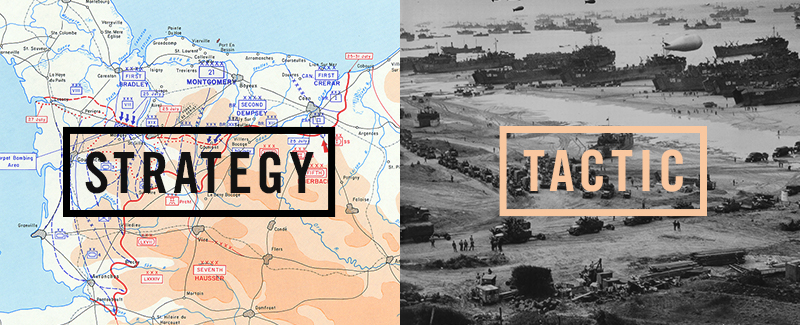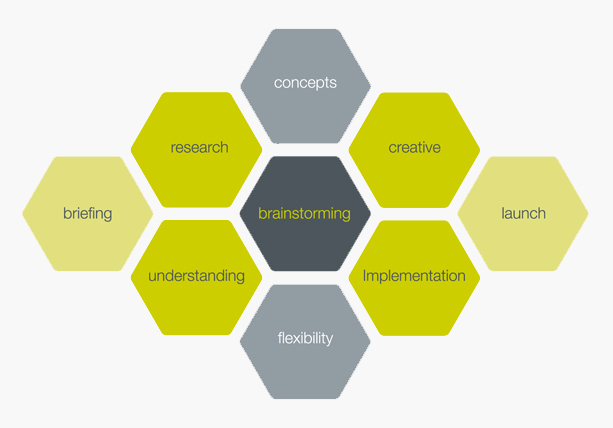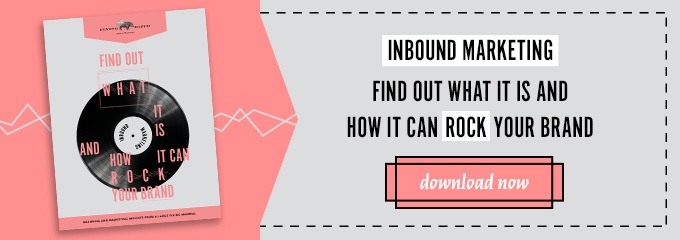 Marketing
Marketing
Let’s Talk Marketing Strategy
Let’s have a talk. (Not that talk.) Let’s talk about marketing strategy.
If there is one word that gets misused too often in marketing, it’s this one.
First, I have some bad news: “Let’s use Twitter” is not a strategy. (It’s a tactic.) Strategy is a calculated approach to a well-defined problem.
- Create a unified Eastern front and force the Germans out of France is a strategy. Storming the beach of Normandy is a tactic to achieve that strategy.
- Be the ultimate destination-shopping experience for all 25-55 year olds is a strategy. Providing a daycare area for their children is a tactic.
- Create the best source of information on brand strategy for small- and medium-sized businesses is a strategy. Writing weekly blog posts about branding is a tactic.
- Build a lifestyle brand for extreme athletes and thrill-seekers is a strategy. Recording a guy jumping from space and posting it on YouTube is a tactic. (Thanks for that one, Red Bull.)
Download our guide to find out how inbound marketing can rock your brand.
Marketing strategy is the high-level approach that will string together multiple tactics toward reaching a specific aim.
I won’t get into the specifics for how to form a strategy. (You could write a book — or about 173,000 of them — on this topic.)
Instead, I want to focus on a question that I — as a strategist — am often asked: So, what do you do, then?
The abstract idea of marketing strategy may make sense to most people, but, there is often still a disconnect in how it looks in practice (and why anyone would want to pay me for it.)
So, why do I have a job? Because this process is complicated:
First, let me say that, as the diagram above shows, the strategy process is not a linear progression.
There’s no formula. Given specific inputs, you won’t always arrive at the same output. And, for any given problem there are an infinite number of potential strategies (some better than others). It’s an art, really, but rooted in some form of science. Strategy is, ultimately, an educated opinion of the best approach.
Looking back at our diagram of strategy in practice, you can see that from left to right, a lot of upfront work goes in before the launch of any hard deliverables. This is sometimes difficult for clients who are used to paying for work hours as they are delivered.
Planes, Trains or Automobiles?
Strategy is sort of like choosing what mode of transportation you’ll use on a trip. Last year, I took a trip to Florida to see some friends. Deciding whether to take a plane or rent a car was a fundamental step, but even after I decided, I still had to book my itinerary, go through the process, show up at the terminal, and make the actual trip. Imagine how your trip might look if you skipped the planning phase and you’ll quickly see why strategy is not only worth paying for, but really the only way to make sure you actually get to where you’re going.
From a defined strategy comes all of the technical and executional details: tactics, budgets, timelines, messaging, etc. Generally, this takes the form of a strategy document or presentation that outlines all of the details that come from the core strategy. When all of the dust settles, what you’re left with is a plan. The plan includes the research, findings, and insights that led to the strategy, along with specifics and creative direction for the execution of the campaign.
Again, all of this is just the groundwork. We’ve yet to open Photoshop or write a single word of copy. But, we now have a clear idea of what we’re setting out to accomplish, how we plan to get there, why we chose that direction, and how it will look in practice.
Strategy isn’t just hyperbole for “sales pitch.” It’s a real process that facilitates creative work and long-term success.
So stop hoping for something different to happen just because you changed a tactic or two. Invest heavily in strategy upfront and trust me, not only will your goal become clearer but the path that will get you there just may surprise you.



